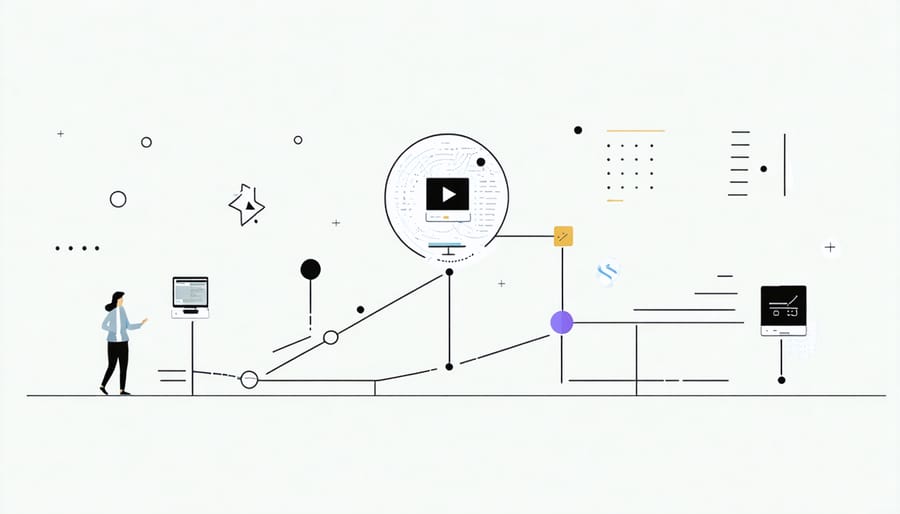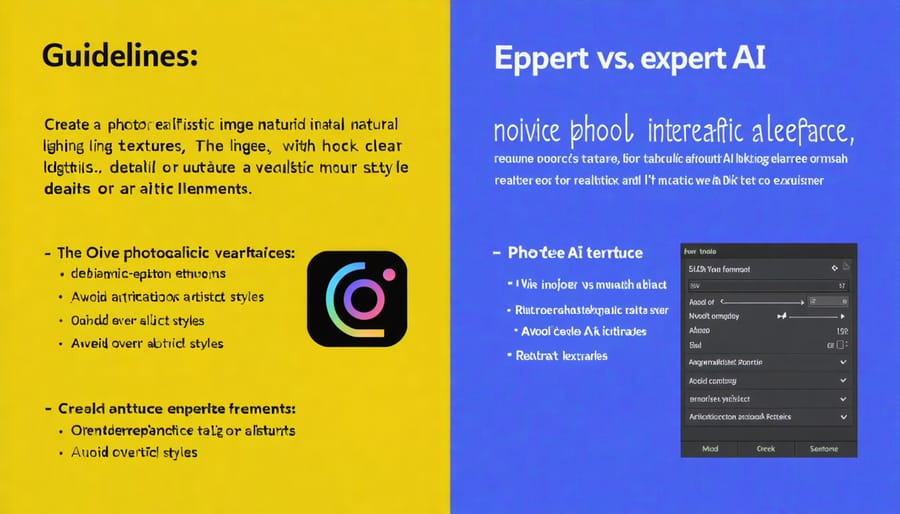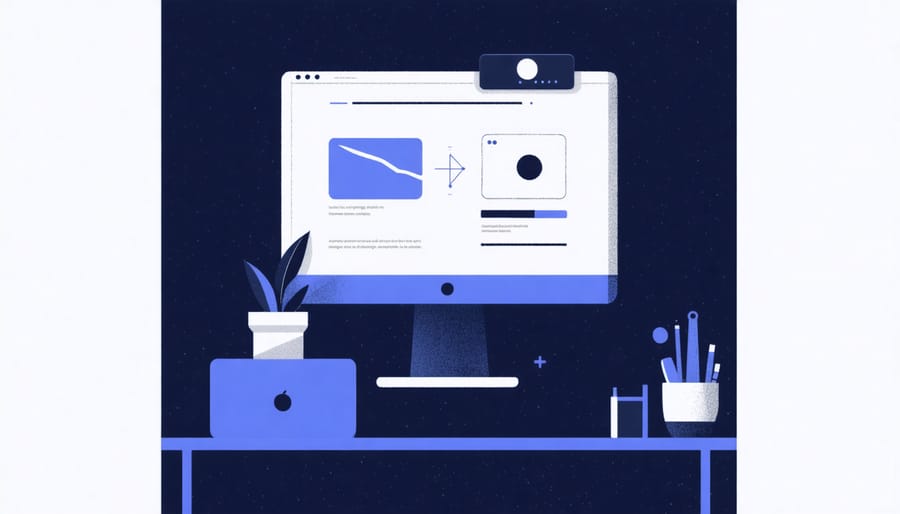Transform your AI journey from novice to expert through our meticulously crafted AI Mastery Program, designed with a structured approach to AI implementation that delivers measurable results within 12 weeks. Master cutting-edge AI tools like ChatGPT, Midjourney, and TensorFlow through hands-on projects, while building a portfolio that demonstrates real-world application skills to potential employers.
Unlike traditional courses that overwhelm with theory, this program focuses on practical mastery through daily micro-learning sessions, interactive workshops, and personalized mentoring from industry experts. Students progress from basic prompt engineering to advanced AI system architecture, completing actual business projects that showcase their growing expertise.
The program’s adaptive learning algorithm adjusts to your pace and learning style, ensuring optimal skill retention and practical application. Whether you’re a complete beginner or an experienced professional, our carefully structured pathway transforms complex AI concepts into manageable, achievement-oriented modules that build upon each other systematically.
Begin your AI mastery journey today with clear milestones, practical assignments, and expert guidance that guarantees proficiency in today’s most in-demand AI technologies.
Why Traditional AI Learning Falls Short
Despite the wealth of AI learning resources available online, many aspiring practitioners find themselves stuck in what we call the “tutorial loop” – endlessly consuming content without making meaningful progress. Traditional self-guided learning approaches often fall short for several key reasons.
First, there’s the overwhelming abundance of information. With countless tutorials, courses, and YouTube videos available, learners frequently struggle to determine which resources are truly valuable and which order to tackle them in. This analysis paralysis can lead to scattered learning and gaps in fundamental knowledge.
Another significant challenge is the lack of structured progression. Many learners jump between advanced topics before mastering the basics, creating a shaky foundation that hampers their long-term progress. Without a clear roadmap, it’s easy to miss crucial concepts or spend too much time on less important areas.
The absence of practical application is perhaps the most critical shortcoming. While theoretical knowledge is important, many self-learners get trapped in passive learning, watching videos and reading articles without hands-on implementation. This leads to a false sense of understanding that quickly evaporates when faced with real-world problems.
Additionally, traditional learning methods often lack accountability and feedback mechanisms. Without regular assessment and expert guidance, learners can develop bad habits or misunderstand important concepts without realizing it. This isolation can also lead to decreased motivation and higher dropout rates.
A structured AI mastery program addresses these challenges by providing:
– A carefully curated curriculum that builds knowledge systematically
– Hands-on projects that reinforce learning through practical application
– Regular feedback and assessment to ensure proper understanding
– A community of peers for support and collaborative learning
– Expert guidance to help navigate complex concepts
– Clear milestones and progress tracking
By addressing these common pitfalls, a well-designed mastery program helps learners move beyond surface-level understanding to achieve true proficiency in AI technologies, saving both time and effort in the learning journey.

The Core Components of Effective AI Tool Mastery
Foundation Building
Before diving into advanced AI tools, it’s crucial to establish a solid foundation in essential AI concepts. This groundwork includes understanding basic programming principles, data structures, and statistical analysis. Think of it as building a house – you need strong foundations before adding the walls and roof.
Start by familiarizing yourself with Python, the primary language for AI development. Focus on fundamental mathematics, particularly linear algebra and probability, as these concepts form the backbone of machine learning algorithms. Don’t worry if these seem challenging at first; many online resources offer beginner-friendly introductions to these topics.
Additionally, develop a working knowledge of data handling and preprocessing techniques. Understanding how to clean, organize, and prepare data sets will prove invaluable as you progress. Familiarize yourself with common AI terminology and basic concepts like supervised learning, neural networks, and natural language processing.
Remember, mastering these fundamentals will significantly accelerate your learning curve when working with advanced AI tools and applications later in the program.
Hands-On Practice Framework
Our hands-on practice framework ensures you develop real-world AI skills through a carefully structured approach. The framework follows a “learn-by-doing” methodology, where each concept is immediately reinforced through practical exercises and real-world projects.
Students begin with guided tutorials that break down complex AI concepts into manageable chunks. These tutorials are followed by independent practice sessions where you’ll work with actual datasets and industry-standard tools. The framework incorporates regular feedback loops, allowing you to assess your progress and adjust your learning path accordingly.
Each practice module includes:
– Interactive coding exercises
– Real-world case studies
– Peer review sessions
– Project-based assessments
– Industry mentor feedback
What sets our framework apart is its adaptive nature. As you progress, the system adjusts the difficulty and complexity of assignments based on your performance. This ensures you’re always challenged but never overwhelmed. Weekly coding challenges and monthly capstone projects help consolidate your learning while building an impressive portfolio of practical AI applications.
To maximize learning effectiveness, we recommend dedicating at least 10 hours per week to hands-on practice, with additional time for reflection and documentation of your learning journey.
Progress Tracking System
The AI Mastery Program features a comprehensive progress tracking system that combines quantitative metrics with qualitative assessments. Students monitor their advancement through interactive dashboards that display completion rates, quiz scores, and project evaluations. Each module includes checkpoint assessments to ensure concept mastery before progression, while skill-based challenges validate practical application abilities.
The system employs a three-tier verification process: knowledge checks through quizzes, hands-on project evaluations, and peer reviews. Progress is measured against personalized learning goals, with adaptive recommendations adjusting to your learning pace. Regular progress reports highlight strengths and areas for improvement, while achievement badges and certificates mark significant milestones.
Students can track their journey through visualization tools that map their skill development across different AI domains, ensuring a balanced and comprehensive learning experience.
Your Week-by-Week Learning Journey
Weeks 1-2: Basic Tool Familiarization
In the first two weeks, you’ll build a solid foundation by exploring and becoming familiar with popular AI platforms like ChatGPT, Google Colab, and TensorFlow. This initial phase focuses on understanding the basic interfaces, navigation, and core functionalities of these essential tools.
You’ll start with hands-on exercises in prompt engineering, learning how to communicate effectively with AI models. Through guided tutorials, you’ll practice creating simple queries, understanding response patterns, and managing AI conversations efficiently. These fundamentals will serve as building blocks for more complex applications later in the program.
The second week introduces basic Python programming concepts specifically relevant to AI applications. You’ll learn to set up your development environment, handle data inputs, and create simple scripts to automate AI interactions. Daily practical exercises ensure you develop muscle memory and confidence in using these tools.
By the end of these two weeks, you’ll be able to navigate AI platforms independently, construct basic prompts, and understand the fundamental workflow of AI-assisted development. This foundation prepares you for more advanced concepts in the following weeks.

Weeks 3-4: Advanced Features and Integration
In weeks 3-4, you’ll dive into sophisticated AI features and learn to combine multiple tools for enhanced productivity. Start by exploring advanced prompt engineering techniques, including chain-of-thought prompting and few-shot learning, which significantly improve AI responses. You’ll master context manipulation and learn to create dynamic system prompts that adapt to different scenarios.
During this phase, you’ll also discover how to integrate various AI tools seamlessly. Learn to combine image generation with text AI, create automated workflows using APIs, and develop custom solutions that leverage multiple AI capabilities. Practice exercises include building a content creation pipeline that uses AI for research, writing, and visual content generation.
The program emphasizes practical applications through hands-on projects. You’ll work on real-world challenges like developing an AI-powered customer service system that combines chatbots with sentiment analysis. Special attention is given to optimization techniques, helping you reduce token usage while maintaining output quality.
By the end of week 4, you’ll be able to orchestrate multiple AI tools effectively, creating sophisticated workflows that solve complex business problems efficiently.
Weeks 5-6: Real-World Application
In these crucial weeks, you’ll transition from theory to hands-on implementation, applying your AI knowledge to solve real business challenges. You’ll work on two comprehensive projects: a customer sentiment analysis system and an automated decision-making tool. These projects incorporate essential responsible AI development practices while delivering practical value.
During Week 5, you’ll develop your sentiment analysis project using popular frameworks like TensorFlow or PyTorch, learning to process and analyze customer feedback data. You’ll also explore cloud deployment options and integration with existing business systems.
Week 6 focuses on building and fine-tuning your automated decision-making tool, which can be customized for various business scenarios such as inventory management or risk assessment. You’ll learn to validate your models, ensure accuracy, and implement feedback loops for continuous improvement.
Throughout these weeks, you’ll participate in peer review sessions, receiving constructive feedback from fellow learners and industry mentors. This practical experience will help you build a portfolio-ready project while developing the confidence to tackle real-world AI challenges.
Weeks 7-8: Optimization and Workflow Mastery
During these pivotal weeks, you’ll learn to streamline your AI workflow and optimize your processes for maximum efficiency. Start by mastering prompt engineering techniques that help you get consistently better results from AI models. You’ll discover how to craft precise instructions that yield exactly what you need, saving valuable time and computational resources.
Practice creating reusable templates and developing systematic approaches to common AI tasks. Learn to automate repetitive processes and build efficient pipelines that connect different AI tools seamlessly. You’ll also explore best practices for managing multiple projects simultaneously while maintaining quality output.
These weeks focus heavily on practical optimization strategies, including resource management, cost reduction, and output quality improvement. You’ll learn to identify bottlenecks in your workflow and implement solutions that enhance productivity. Special attention is given to version control and documentation practices that make your work reproducible and scalable.
By the end of this module, you’ll have developed a personalized workflow that maximizes your effectiveness with AI tools while minimizing wasted effort and resources. This optimization foundation will prove invaluable as you tackle more complex projects in the future.
Measuring Your Success

Skill Assessment Benchmarks
To track your progress in the AI Mastery Program, we’ve established clear benchmarks across three proficiency levels. At the foundational level, you should be able to explain basic AI concepts, work with simple machine learning algorithms, and complete basic data preprocessing tasks with 90% accuracy. These skills are typically achieved within the first three months of dedicated study.
The intermediate benchmark demonstrates your ability to implement various AI models independently, optimize hyperparameters, and handle complex datasets. You should be capable of building and deploying simple AI applications and achieving model accuracy rates above 85% on standard datasets. This level usually requires 4-6 months of consistent practice.
Advanced mastery is marked by the ability to design and implement sophisticated AI solutions, optimize model performance, and handle real-world applications with multiple variables. Key indicators include successfully completing end-to-end AI projects, contributing to open-source AI initiatives, and achieving benchmark-beating results on industry-standard problems. You’ll also be able to explain complex AI concepts to others and troubleshoot advanced implementation issues. This level typically requires 8-12 months of dedicated learning and practical application.
Each level includes hands-on projects and assessments to verify your capabilities and ensure you’re ready to progress to the next stage.
Portfolio Development
Building a strong portfolio is essential to demonstrate your expertise in AI tools and technologies. Start by documenting your journey through hands-on projects that showcase your ability to solve real-world problems. Create a GitHub repository to store your code implementations and experiments, demonstrating your practical understanding of various AI frameworks and tools.
Focus on developing projects that highlight different aspects of practical AI applications, such as natural language processing, computer vision, or predictive analytics. Include detailed documentation explaining your approach, challenges faced, and solutions implemented. This helps potential employers or clients understand your problem-solving process.
Consider contributing to open-source AI projects or participating in AI competitions on platforms like Kaggle. These activities not only enhance your portfolio but also provide opportunities to collaborate with other AI enthusiasts and learn from their experiences. Additionally, maintain a blog or technical documentation showcasing your insights and learnings from working with various AI tools.
Remember to regularly update your portfolio with new projects and skills as you progress through the AI mastery program. This ongoing development demonstrates your commitment to continuous learning and growth in the field.

Common Obstacles and Solutions
Technical Hurdles
Learning AI comes with its share of technical challenges, but with the right approach, these hurdles become stepping stones to mastery. One common obstacle is setting up the development environment, particularly when dealing with multiple frameworks and dependencies. To overcome this, start with containerized environments using Docker, which ensures consistency across different systems and simplifies setup processes.
Memory management often poses another significant challenge, especially when working with large datasets or complex models. Implement efficient data loading techniques, such as batch processing and data generators, to handle memory constraints effectively. For those working with limited computational resources, consider using cloud computing platforms or optimizing model architectures for better performance.
Debugging AI models can be particularly tricky due to their black-box nature. Utilize visualization tools like TensorBoard or Weights & Biases to monitor training progress and identify potential issues early. Keep detailed logs of your experiments and maintain version control of your code and model iterations.
Framework compatibility issues may arise when integrating different AI tools. Stay updated with the latest stable versions and maintain clear documentation of your development environment. When facing error messages, approach them systematically by checking official documentation and community forums.
Remember that these technical challenges are part of the learning process. Build a strong foundation in Python programming and basic mathematics before diving into complex AI implementations. Join online communities and participate in forums where you can share experiences and solutions with fellow learners.
Learning Plateau Solutions
Every learner encounters plateaus in their AI mastery journey, but these temporary slowdowns don’t have to derail your progress. The key is recognizing these plateaus as opportunities for strategic advancement rather than roadblocks.
One effective strategy is the “side-step approach” – instead of pushing harder at the same concept, shift your focus to a related but different aspect of AI. For example, if you’re stuck on neural networks, temporarily switch to exploring data preprocessing or feature engineering. This lateral movement often leads to breakthrough insights that help overcome the original obstacle.
Implementation of the “teach to learn” method can also break through plateaus. Explaining concepts to others, whether through blog posts, study groups, or mentoring, forces you to understand topics more deeply and often reveals gaps in your knowledge that may be causing the plateau.
Regular project rotation is another powerful technique. Working on diverse projects prevents cognitive fatigue and maintains engagement. Try alternating between different AI domains – computer vision one week, natural language processing the next.
Finally, consider the “deconstruction technique” – breaking down complex concepts into smaller, manageable pieces. If you’re struggling with advanced algorithms, return to their foundational components and rebuild your understanding from the ground up.
Remember, plateaus are natural parts of the learning process. By applying these strategies systematically, you can transform these challenging periods into opportunities for deeper mastery.
Embarking on an AI mastery program is more than just acquiring technical skills – it’s about transforming your career trajectory and positioning yourself at the forefront of technological innovation. Through structured learning paths, hands-on projects, and expert guidance, you’ll develop a comprehensive understanding of artificial intelligence that goes beyond theoretical knowledge.
The benefits of completing this program are substantial and far-reaching. You’ll gain practical expertise in machine learning algorithms, deep learning frameworks, and AI applications that are highly sought after in today’s job market. The program’s emphasis on real-world projects ensures you’ll build a compelling portfolio that demonstrates your capabilities to potential employers.
Moreover, you’ll join a vibrant community of AI enthusiasts and professionals, creating valuable networking opportunities and potential collaborations. The flexible learning format allows you to progress at your own pace while maintaining a structured approach to skill development.
Ready to take the next step? Begin by assessing your current knowledge level and choosing the appropriate entry point into the program. Whether you’re a complete beginner or have some programming experience, there’s a tailored path waiting for you. Consider scheduling a consultation with our program advisors to discuss your goals and create a personalized learning plan.
Remember, mastering AI is a journey that requires dedication and consistent effort. However, with the right guidance, support system, and structured approach provided by this program, you’ll be well-equipped to navigate the exciting world of artificial intelligence and emerge as a skilled practitioner ready to tackle real-world challenges.
Take action now and join the next cohort of AI innovators. Your journey to AI mastery starts here.

